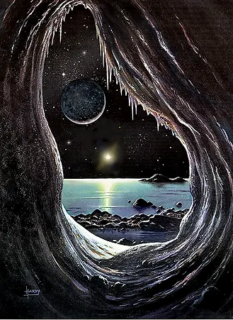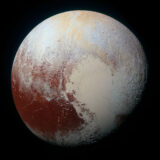The talk to members at our October 2024 meeting of the Orpington Astronomical Society was given by Tony Sizer our Programme Secretary who has been involved with the Royal Observatory Greenwich for 45 years. His talk titled Out of the Darkness: The World that is Pluto discussed those involved in trying to find Pluto and its ultimate discovery in 1930. The talk also covered how Pluto was subsequently redefined as a dwarf planet.
 Tony started his talk with a painting by David Hardy based on a photograph by Herbert Ponting. The painting was subsequently revised after the discovery of Charon – Pluto’s largest moon. Pluto was first predicted due to the irregularities in the orbits of Uranus and Neptune and Tony described the work of Percival Lowell and William Henry Pickering and the telescopes they used. Clyde Tombaugh an American astronomer at the Lowell Observatory finally discovered Pluto by using a blink comparator to view the differences between multiple photos and his discovery led to a busy period of research.
Tony started his talk with a painting by David Hardy based on a photograph by Herbert Ponting. The painting was subsequently revised after the discovery of Charon – Pluto’s largest moon. Pluto was first predicted due to the irregularities in the orbits of Uranus and Neptune and Tony described the work of Percival Lowell and William Henry Pickering and the telescopes they used. Clyde Tombaugh an American astronomer at the Lowell Observatory finally discovered Pluto by using a blink comparator to view the differences between multiple photos and his discovery led to a busy period of research.
 Pluto was named after the Roman god of the underworld when an 11 year old girl, Venetia Burney suggested this name to her grandfather. Tony pointed out that Disney named Mickey Mouse’s pet dog Pluto a year later. After the discovery of Pluto astronomers continued to find sizeable objects in the Kuiper Belt – but all smaller than the Earth’s moon.
Pluto was named after the Roman god of the underworld when an 11 year old girl, Venetia Burney suggested this name to her grandfather. Tony pointed out that Disney named Mickey Mouse’s pet dog Pluto a year later. After the discovery of Pluto astronomers continued to find sizeable objects in the Kuiper Belt – but all smaller than the Earth’s moon.

Given the small size of Pluto and the many other similar sized objects circling the Sun, Pluto posed a problem in being defined as a planet. In 2006, after years of debate, the International Astronomical Union (IAU) demoted Pluto from its position as the ninth planet to a ‘dwarf planet’. This demotion unexpectedly led to protests and the IAU has since had several attempts in trying to redefine Pluto.
 Tony’s talk also featured the discoveries of the New Horizons spacecraft which was launched by NASA in 2006 to study Pluto and the Kuiper Belt. In 2015 it made a historic flyby which captured detailed images and data, revealing a complex and fascinating world with mountains, plains, volcanic features and a thin atmosphere. Research into Pluto continues as does the debate about its definition.
Tony’s talk also featured the discoveries of the New Horizons spacecraft which was launched by NASA in 2006 to study Pluto and the Kuiper Belt. In 2015 it made a historic flyby which captured detailed images and data, revealing a complex and fascinating world with mountains, plains, volcanic features and a thin atmosphere. Research into Pluto continues as does the debate about its definition.
Prepared by Jim Worthington

